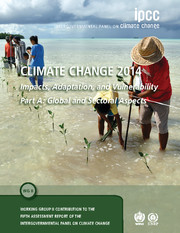 Climate Change 2014 – Impacts, Adaptation and Vulnerability: Part A: Global and Sectoral Aspects
Climate Change 2014 – Impacts, Adaptation and Vulnerability: Part A: Global and Sectoral Aspects Foreword
Published online by Cambridge University Press: 05 January 2015
Summary
Climate Change 2014: Impacts, Adaptation, and Vulnerability is the second volume of the Fifth Assessment Report (AR5) of the Intergovernmental Panel on Climate Change (IPCC) — Climate Change 2013/2014 — and was prepared by its Working Group II. The volume focuses on why climate change matters and is organized into two parts, devoted respectively to human and natural systems and regional aspects, incorporating results from the reports of Working Groups I and III. The volume addresses impacts that have already occurred and risks of future impacts, especially the way those risks change with the amount of climate change that occurs and with investments in adaptation to climate changes that cannot be avoided. For both past and future impacts, a core focus of the assessment is characterizing knowledge about vulnerability, the characteristics and interactions that make some events devastating, while others pass with little notice.
Three elements are new in this assessment. Each contributes to a richer, more nuanced understanding of climate change in its real-world context. The first new element is a major expansion of the topics covered in the assessment. In moving from 20 chapters in the AR4 to 30 in the AR5, the Working Group II assessment makes it clear that expanding knowledge about climate change and its impacts mandates attention to more sectors, including sectors related to human security, livelihoods, and the oceans. The second new element is a pervasive focus on risk, where risk captures the combination of uncertain outcomes and something of value at stake. A framing based on risk provides a framework for utilizing information on the full range of possible outcomes, including not only most likely outcomes but also low probability but high consequence events. The third new element is solid grounding in the evidence that impacts of climate change typically involve a number of interacting factors, with climate change adding new dimensions and complications.
- Type
- Chapter
- Information
- Climate Change 2014 – Impacts, Adaptation and Vulnerability: Part A: Global and Sectoral AspectsWorking Group II Contribution to the IPCC Fifth Assessment Report, pp. vii - viiiPublisher: Cambridge University PressPrint publication year: 2014
- 5
- Cited by


